Detailed Summary: Kotter's 8-Step Change Model Explained
VerifiedAdded on 2021/06/30
|19
|5289
|1056
Report
AI Summary
This report provides a detailed summary of John Kotter's 8-step change model, a framework for successful organizational transformation. It begins by emphasizing the importance of creating a sense of urgency among stakeholders, followed by forming a powerful guiding coalition to lead the change. The report then highlights the need to create a clear vision for change and develop effective strategies to achieve it. Key steps discussed include identifying potential threats, examining opportunities, and fostering open communication. The model emphasizes the importance of team building, identifying true leaders, and ensuring a diverse coalition. The report explains each of the eight steps, providing insights into the dynamics leaders must follow, the action steps required, and strategies for success. The report underscores the critical elements of urgency and removing barriers, offering a comprehensive checklist for change implementation. The content underscores the need for leaders to be open-minded, provide authentic statistics, and gain stakeholder support to drive change effectively.
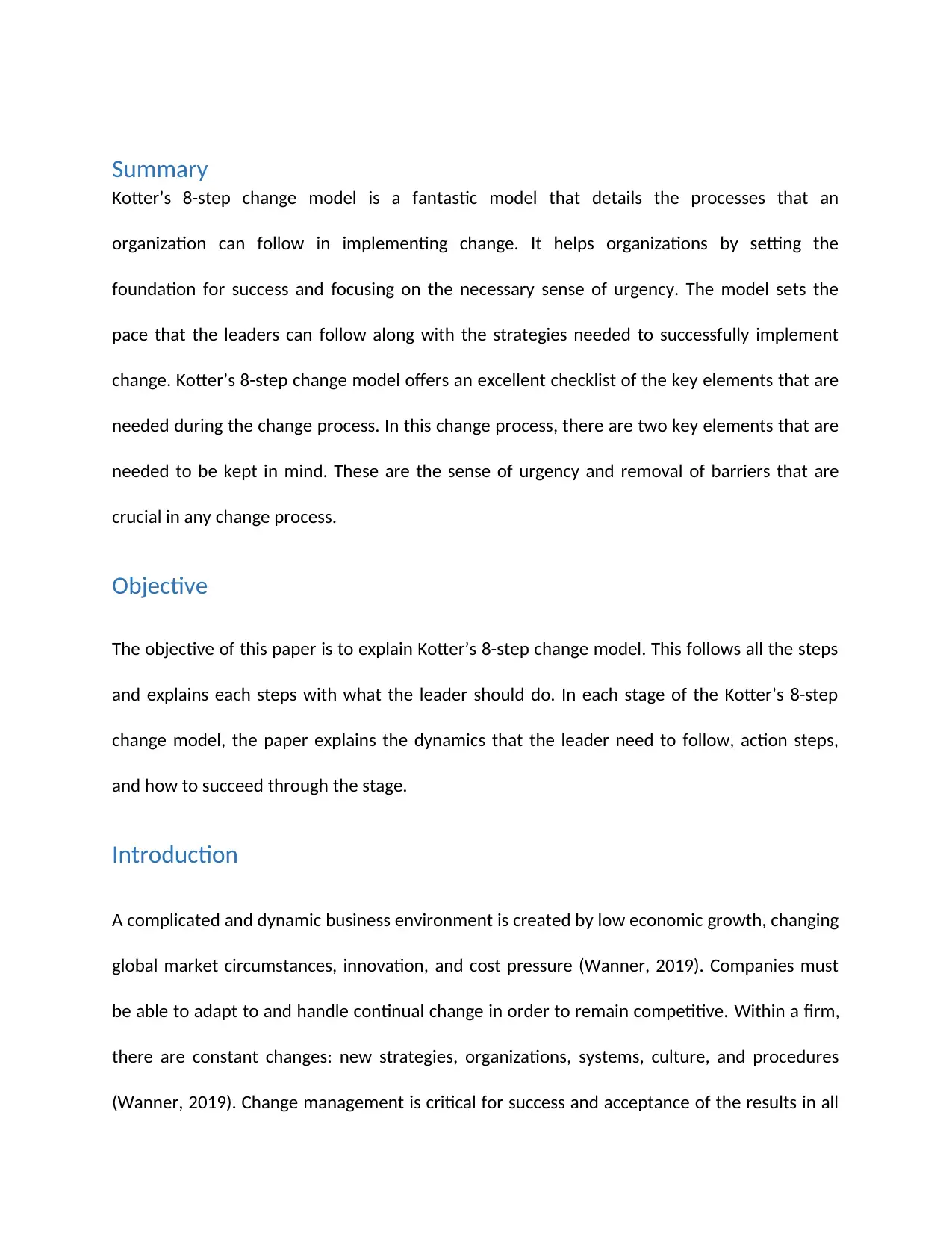
Summary
Kotter’s 8-step change model is a fantastic model that details the processes that an
organization can follow in implementing change. It helps organizations by setting the
foundation for success and focusing on the necessary sense of urgency. The model sets the
pace that the leaders can follow along with the strategies needed to successfully implement
change. Kotter’s 8-step change model offers an excellent checklist of the key elements that are
needed during the change process. In this change process, there are two key elements that are
needed to be kept in mind. These are the sense of urgency and removal of barriers that are
crucial in any change process.
Objective
The objective of this paper is to explain Kotter’s 8-step change model. This follows all the steps
and explains each steps with what the leader should do. In each stage of the Kotter’s 8-step
change model, the paper explains the dynamics that the leader need to follow, action steps,
and how to succeed through the stage.
Introduction
A complicated and dynamic business environment is created by low economic growth, changing
global market circumstances, innovation, and cost pressure (Wanner, 2019). Companies must
be able to adapt to and handle continual change in order to remain competitive. Within a firm,
there are constant changes: new strategies, organizations, systems, culture, and procedures
(Wanner, 2019). Change management is critical for success and acceptance of the results in all
Kotter’s 8-step change model is a fantastic model that details the processes that an
organization can follow in implementing change. It helps organizations by setting the
foundation for success and focusing on the necessary sense of urgency. The model sets the
pace that the leaders can follow along with the strategies needed to successfully implement
change. Kotter’s 8-step change model offers an excellent checklist of the key elements that are
needed during the change process. In this change process, there are two key elements that are
needed to be kept in mind. These are the sense of urgency and removal of barriers that are
crucial in any change process.
Objective
The objective of this paper is to explain Kotter’s 8-step change model. This follows all the steps
and explains each steps with what the leader should do. In each stage of the Kotter’s 8-step
change model, the paper explains the dynamics that the leader need to follow, action steps,
and how to succeed through the stage.
Introduction
A complicated and dynamic business environment is created by low economic growth, changing
global market circumstances, innovation, and cost pressure (Wanner, 2019). Companies must
be able to adapt to and handle continual change in order to remain competitive. Within a firm,
there are constant changes: new strategies, organizations, systems, culture, and procedures
(Wanner, 2019). Change management is critical for success and acceptance of the results in all
Paraphrase This Document
Need a fresh take? Get an instant paraphrase of this document with our AI Paraphraser
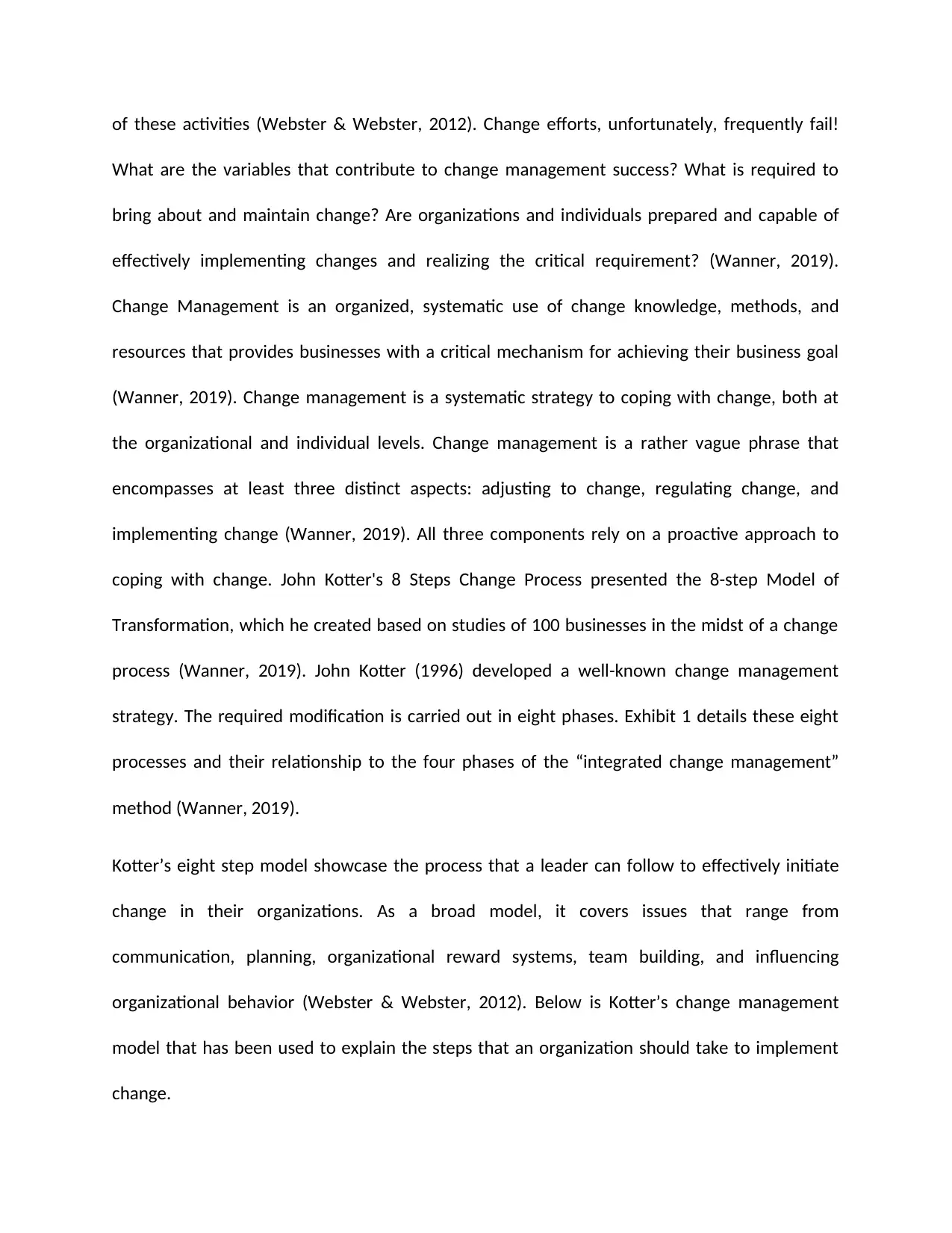
of these activities (Webster & Webster, 2012). Change efforts, unfortunately, frequently fail!
What are the variables that contribute to change management success? What is required to
bring about and maintain change? Are organizations and individuals prepared and capable of
effectively implementing changes and realizing the critical requirement? (Wanner, 2019).
Change Management is an organized, systematic use of change knowledge, methods, and
resources that provides businesses with a critical mechanism for achieving their business goal
(Wanner, 2019). Change management is a systematic strategy to coping with change, both at
the organizational and individual levels. Change management is a rather vague phrase that
encompasses at least three distinct aspects: adjusting to change, regulating change, and
implementing change (Wanner, 2019). All three components rely on a proactive approach to
coping with change. John Kotter's 8 Steps Change Process presented the 8-step Model of
Transformation, which he created based on studies of 100 businesses in the midst of a change
process (Wanner, 2019). John Kotter (1996) developed a well-known change management
strategy. The required modification is carried out in eight phases. Exhibit 1 details these eight
processes and their relationship to the four phases of the “integrated change management”
method (Wanner, 2019).
Kotter’s eight step model showcase the process that a leader can follow to effectively initiate
change in their organizations. As a broad model, it covers issues that range from
communication, planning, organizational reward systems, team building, and influencing
organizational behavior (Webster & Webster, 2012). Below is Kotter’s change management
model that has been used to explain the steps that an organization should take to implement
change.
What are the variables that contribute to change management success? What is required to
bring about and maintain change? Are organizations and individuals prepared and capable of
effectively implementing changes and realizing the critical requirement? (Wanner, 2019).
Change Management is an organized, systematic use of change knowledge, methods, and
resources that provides businesses with a critical mechanism for achieving their business goal
(Wanner, 2019). Change management is a systematic strategy to coping with change, both at
the organizational and individual levels. Change management is a rather vague phrase that
encompasses at least three distinct aspects: adjusting to change, regulating change, and
implementing change (Wanner, 2019). All three components rely on a proactive approach to
coping with change. John Kotter's 8 Steps Change Process presented the 8-step Model of
Transformation, which he created based on studies of 100 businesses in the midst of a change
process (Wanner, 2019). John Kotter (1996) developed a well-known change management
strategy. The required modification is carried out in eight phases. Exhibit 1 details these eight
processes and their relationship to the four phases of the “integrated change management”
method (Wanner, 2019).
Kotter’s eight step model showcase the process that a leader can follow to effectively initiate
change in their organizations. As a broad model, it covers issues that range from
communication, planning, organizational reward systems, team building, and influencing
organizational behavior (Webster & Webster, 2012). Below is Kotter’s change management
model that has been used to explain the steps that an organization should take to implement
change.
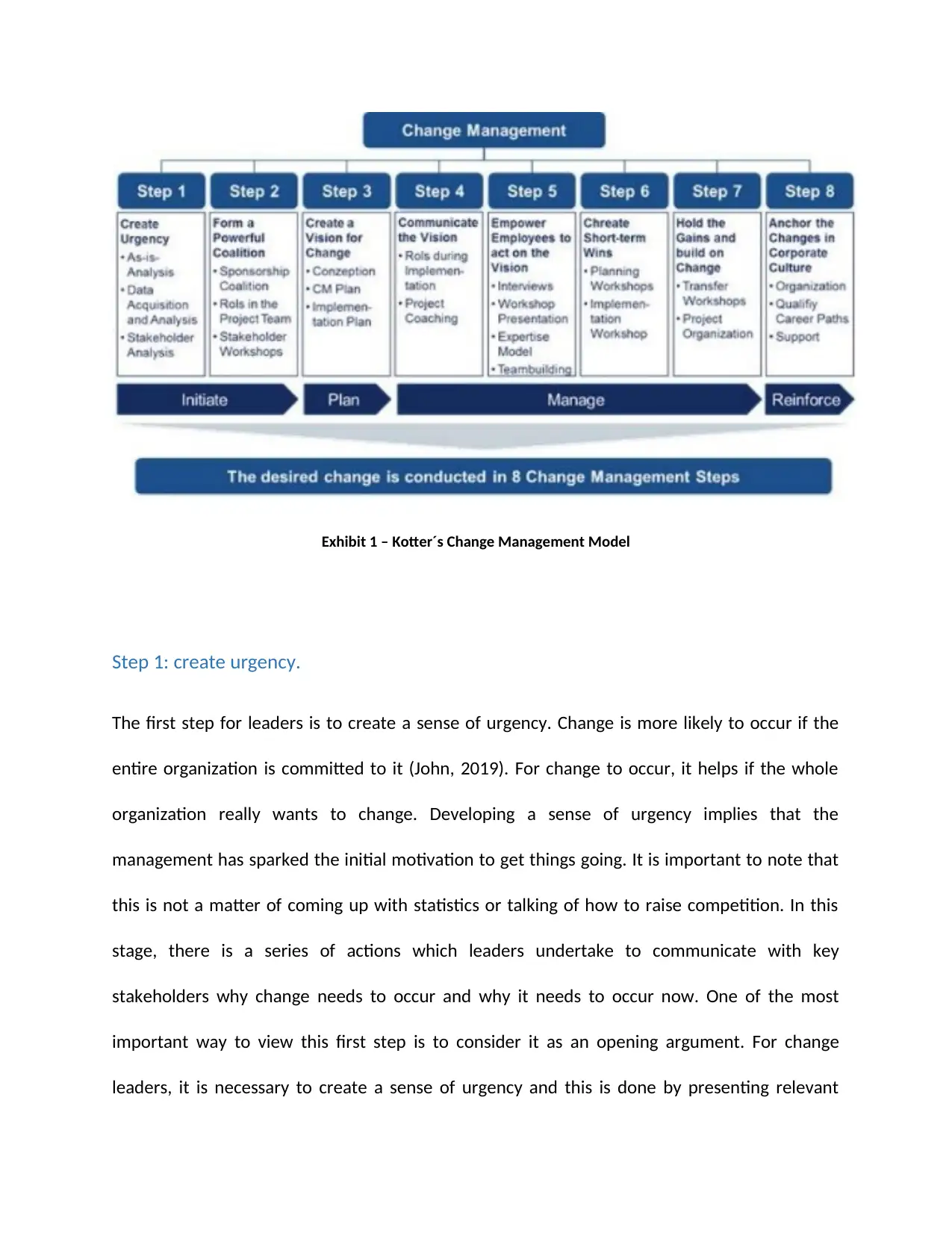
Exhibit 1 – Kotter´s Change Management Model
Step 1: create urgency.
The first step for leaders is to create a sense of urgency. Change is more likely to occur if the
entire organization is committed to it (John, 2019). For change to occur, it helps if the whole
organization really wants to change. Developing a sense of urgency implies that the
management has sparked the initial motivation to get things going. It is important to note that
this is not a matter of coming up with statistics or talking of how to raise competition. In this
stage, there is a series of actions which leaders undertake to communicate with key
stakeholders why change needs to occur and why it needs to occur now. One of the most
important way to view this first step is to consider it as an opening argument. For change
leaders, it is necessary to create a sense of urgency and this is done by presenting relevant
Step 1: create urgency.
The first step for leaders is to create a sense of urgency. Change is more likely to occur if the
entire organization is committed to it (John, 2019). For change to occur, it helps if the whole
organization really wants to change. Developing a sense of urgency implies that the
management has sparked the initial motivation to get things going. It is important to note that
this is not a matter of coming up with statistics or talking of how to raise competition. In this
stage, there is a series of actions which leaders undertake to communicate with key
stakeholders why change needs to occur and why it needs to occur now. One of the most
important way to view this first step is to consider it as an opening argument. For change
leaders, it is necessary to create a sense of urgency and this is done by presenting relevant
⊘ This is a preview!⊘
Do you want full access?
Subscribe today to unlock all pages.

Trusted by 1+ million students worldwide
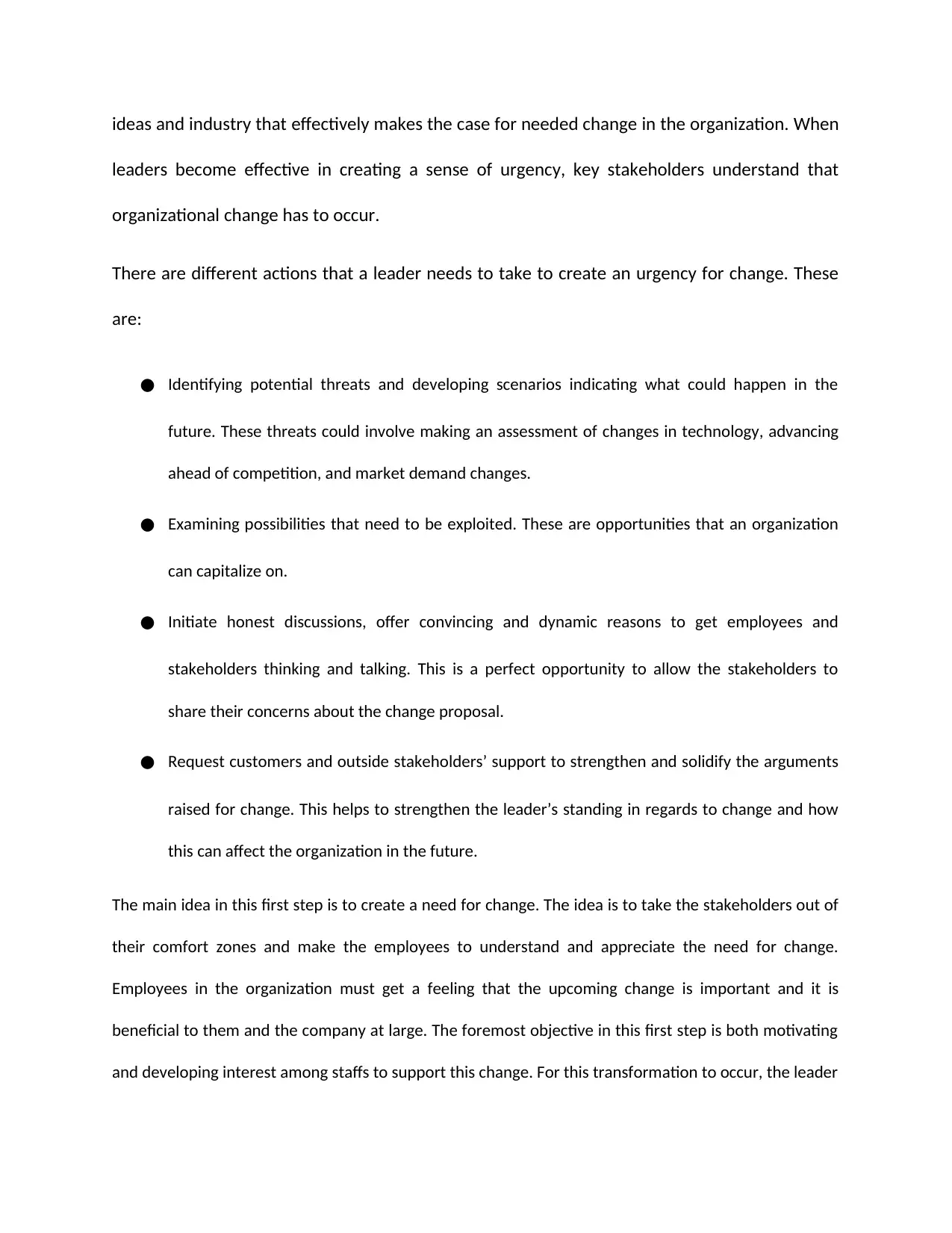
ideas and industry that effectively makes the case for needed change in the organization. When
leaders become effective in creating a sense of urgency, key stakeholders understand that
organizational change has to occur.
There are different actions that a leader needs to take to create an urgency for change. These
are:
● Identifying potential threats and developing scenarios indicating what could happen in the
future. These threats could involve making an assessment of changes in technology, advancing
ahead of competition, and market demand changes.
● Examining possibilities that need to be exploited. These are opportunities that an organization
can capitalize on.
● Initiate honest discussions, offer convincing and dynamic reasons to get employees and
stakeholders thinking and talking. This is a perfect opportunity to allow the stakeholders to
share their concerns about the change proposal.
● Request customers and outside stakeholders’ support to strengthen and solidify the arguments
raised for change. This helps to strengthen the leader’s standing in regards to change and how
this can affect the organization in the future.
The main idea in this first step is to create a need for change. The idea is to take the stakeholders out of
their comfort zones and make the employees to understand and appreciate the need for change.
Employees in the organization must get a feeling that the upcoming change is important and it is
beneficial to them and the company at large. The foremost objective in this first step is both motivating
and developing interest among staffs to support this change. For this transformation to occur, the leader
leaders become effective in creating a sense of urgency, key stakeholders understand that
organizational change has to occur.
There are different actions that a leader needs to take to create an urgency for change. These
are:
● Identifying potential threats and developing scenarios indicating what could happen in the
future. These threats could involve making an assessment of changes in technology, advancing
ahead of competition, and market demand changes.
● Examining possibilities that need to be exploited. These are opportunities that an organization
can capitalize on.
● Initiate honest discussions, offer convincing and dynamic reasons to get employees and
stakeholders thinking and talking. This is a perfect opportunity to allow the stakeholders to
share their concerns about the change proposal.
● Request customers and outside stakeholders’ support to strengthen and solidify the arguments
raised for change. This helps to strengthen the leader’s standing in regards to change and how
this can affect the organization in the future.
The main idea in this first step is to create a need for change. The idea is to take the stakeholders out of
their comfort zones and make the employees to understand and appreciate the need for change.
Employees in the organization must get a feeling that the upcoming change is important and it is
beneficial to them and the company at large. The foremost objective in this first step is both motivating
and developing interest among staffs to support this change. For this transformation to occur, the leader
Paraphrase This Document
Need a fresh take? Get an instant paraphrase of this document with our AI Paraphraser
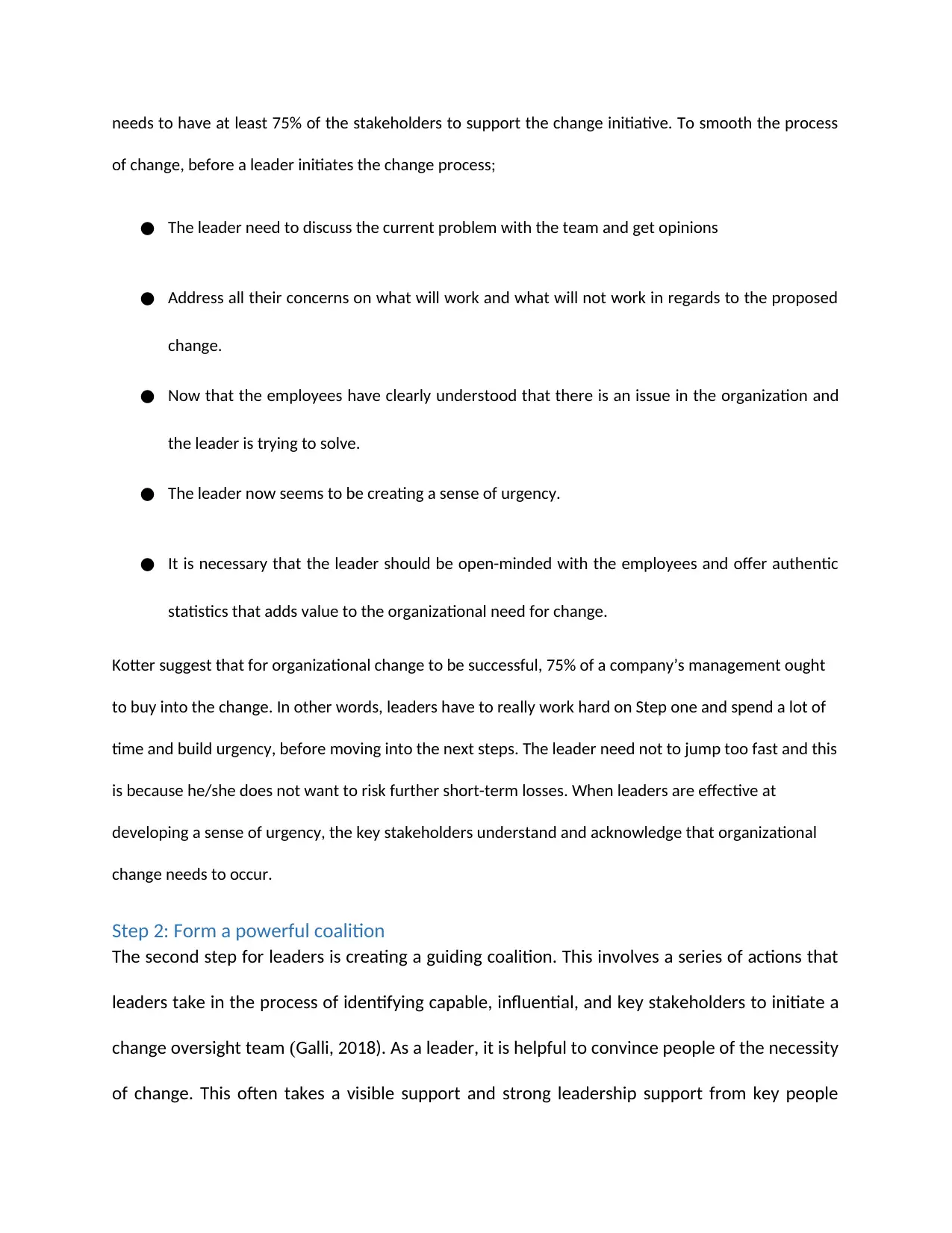
needs to have at least 75% of the stakeholders to support the change initiative. To smooth the process
of change, before a leader initiates the change process;
● The leader need to discuss the current problem with the team and get opinions
● Address all their concerns on what will work and what will not work in regards to the proposed
change.
● Now that the employees have clearly understood that there is an issue in the organization and
the leader is trying to solve.
● The leader now seems to be creating a sense of urgency.
● It is necessary that the leader should be open-minded with the employees and offer authentic
statistics that adds value to the organizational need for change.
Kotter suggest that for organizational change to be successful, 75% of a company’s management ought
to buy into the change. In other words, leaders have to really work hard on Step one and spend a lot of
time and build urgency, before moving into the next steps. The leader need not to jump too fast and this
is because he/she does not want to risk further short-term losses. When leaders are effective at
developing a sense of urgency, the key stakeholders understand and acknowledge that organizational
change needs to occur.
Step 2: Form a powerful coalition
The second step for leaders is creating a guiding coalition. This involves a series of actions that
leaders take in the process of identifying capable, influential, and key stakeholders to initiate a
change oversight team (Galli, 2018). As a leader, it is helpful to convince people of the necessity
of change. This often takes a visible support and strong leadership support from key people
of change, before a leader initiates the change process;
● The leader need to discuss the current problem with the team and get opinions
● Address all their concerns on what will work and what will not work in regards to the proposed
change.
● Now that the employees have clearly understood that there is an issue in the organization and
the leader is trying to solve.
● The leader now seems to be creating a sense of urgency.
● It is necessary that the leader should be open-minded with the employees and offer authentic
statistics that adds value to the organizational need for change.
Kotter suggest that for organizational change to be successful, 75% of a company’s management ought
to buy into the change. In other words, leaders have to really work hard on Step one and spend a lot of
time and build urgency, before moving into the next steps. The leader need not to jump too fast and this
is because he/she does not want to risk further short-term losses. When leaders are effective at
developing a sense of urgency, the key stakeholders understand and acknowledge that organizational
change needs to occur.
Step 2: Form a powerful coalition
The second step for leaders is creating a guiding coalition. This involves a series of actions that
leaders take in the process of identifying capable, influential, and key stakeholders to initiate a
change oversight team (Galli, 2018). As a leader, it is helpful to convince people of the necessity
of change. This often takes a visible support and strong leadership support from key people
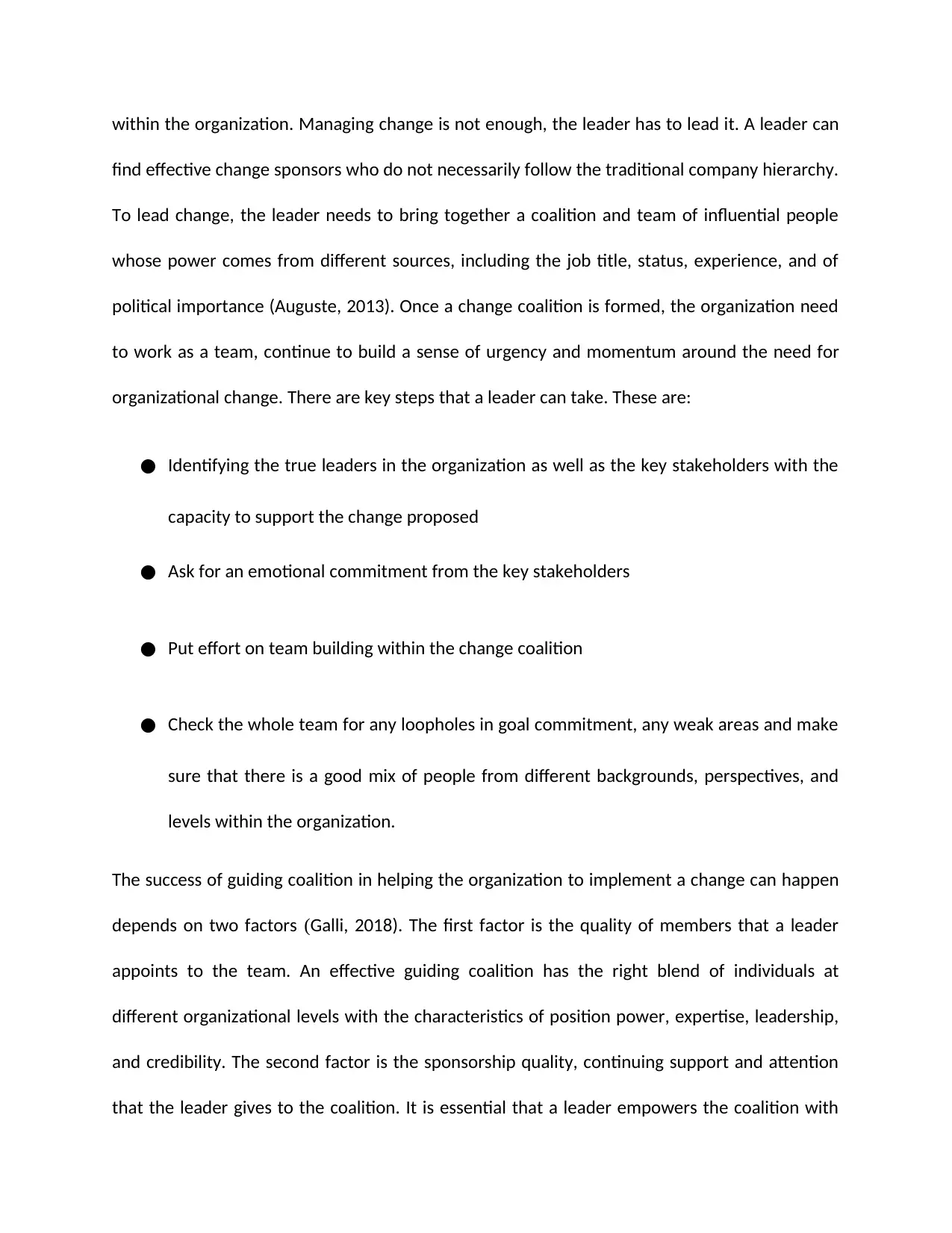
within the organization. Managing change is not enough, the leader has to lead it. A leader can
find effective change sponsors who do not necessarily follow the traditional company hierarchy.
To lead change, the leader needs to bring together a coalition and team of influential people
whose power comes from different sources, including the job title, status, experience, and of
political importance (Auguste, 2013). Once a change coalition is formed, the organization need
to work as a team, continue to build a sense of urgency and momentum around the need for
organizational change. There are key steps that a leader can take. These are:
● Identifying the true leaders in the organization as well as the key stakeholders with the
capacity to support the change proposed
● Ask for an emotional commitment from the key stakeholders
● Put effort on team building within the change coalition
● Check the whole team for any loopholes in goal commitment, any weak areas and make
sure that there is a good mix of people from different backgrounds, perspectives, and
levels within the organization.
The success of guiding coalition in helping the organization to implement a change can happen
depends on two factors (Galli, 2018). The first factor is the quality of members that a leader
appoints to the team. An effective guiding coalition has the right blend of individuals at
different organizational levels with the characteristics of position power, expertise, leadership,
and credibility. The second factor is the sponsorship quality, continuing support and attention
that the leader gives to the coalition. It is essential that a leader empowers the coalition with
find effective change sponsors who do not necessarily follow the traditional company hierarchy.
To lead change, the leader needs to bring together a coalition and team of influential people
whose power comes from different sources, including the job title, status, experience, and of
political importance (Auguste, 2013). Once a change coalition is formed, the organization need
to work as a team, continue to build a sense of urgency and momentum around the need for
organizational change. There are key steps that a leader can take. These are:
● Identifying the true leaders in the organization as well as the key stakeholders with the
capacity to support the change proposed
● Ask for an emotional commitment from the key stakeholders
● Put effort on team building within the change coalition
● Check the whole team for any loopholes in goal commitment, any weak areas and make
sure that there is a good mix of people from different backgrounds, perspectives, and
levels within the organization.
The success of guiding coalition in helping the organization to implement a change can happen
depends on two factors (Galli, 2018). The first factor is the quality of members that a leader
appoints to the team. An effective guiding coalition has the right blend of individuals at
different organizational levels with the characteristics of position power, expertise, leadership,
and credibility. The second factor is the sponsorship quality, continuing support and attention
that the leader gives to the coalition. It is essential that a leader empowers the coalition with
⊘ This is a preview!⊘
Do you want full access?
Subscribe today to unlock all pages.

Trusted by 1+ million students worldwide
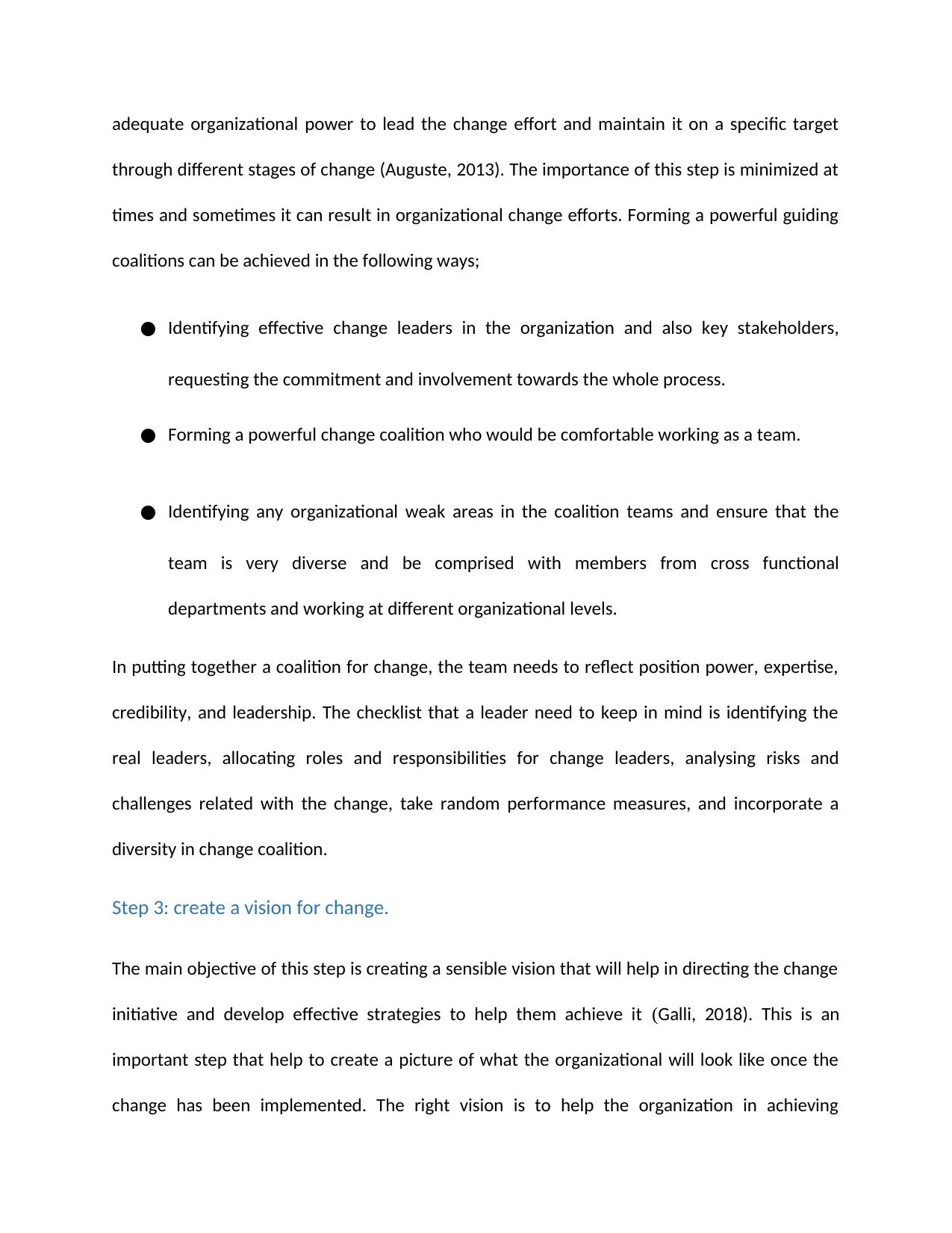
adequate organizational power to lead the change effort and maintain it on a specific target
through different stages of change (Auguste, 2013). The importance of this step is minimized at
times and sometimes it can result in organizational change efforts. Forming a powerful guiding
coalitions can be achieved in the following ways;
● Identifying effective change leaders in the organization and also key stakeholders,
requesting the commitment and involvement towards the whole process.
● Forming a powerful change coalition who would be comfortable working as a team.
● Identifying any organizational weak areas in the coalition teams and ensure that the
team is very diverse and be comprised with members from cross functional
departments and working at different organizational levels.
In putting together a coalition for change, the team needs to reflect position power, expertise,
credibility, and leadership. The checklist that a leader need to keep in mind is identifying the
real leaders, allocating roles and responsibilities for change leaders, analysing risks and
challenges related with the change, take random performance measures, and incorporate a
diversity in change coalition.
Step 3: create a vision for change.
The main objective of this step is creating a sensible vision that will help in directing the change
initiative and develop effective strategies to help them achieve it (Galli, 2018). This is an
important step that help to create a picture of what the organizational will look like once the
change has been implemented. The right vision is to help the organization in achieving
through different stages of change (Auguste, 2013). The importance of this step is minimized at
times and sometimes it can result in organizational change efforts. Forming a powerful guiding
coalitions can be achieved in the following ways;
● Identifying effective change leaders in the organization and also key stakeholders,
requesting the commitment and involvement towards the whole process.
● Forming a powerful change coalition who would be comfortable working as a team.
● Identifying any organizational weak areas in the coalition teams and ensure that the
team is very diverse and be comprised with members from cross functional
departments and working at different organizational levels.
In putting together a coalition for change, the team needs to reflect position power, expertise,
credibility, and leadership. The checklist that a leader need to keep in mind is identifying the
real leaders, allocating roles and responsibilities for change leaders, analysing risks and
challenges related with the change, take random performance measures, and incorporate a
diversity in change coalition.
Step 3: create a vision for change.
The main objective of this step is creating a sensible vision that will help in directing the change
initiative and develop effective strategies to help them achieve it (Galli, 2018). This is an
important step that help to create a picture of what the organizational will look like once the
change has been implemented. The right vision is to help the organization in achieving
Paraphrase This Document
Need a fresh take? Get an instant paraphrase of this document with our AI Paraphraser
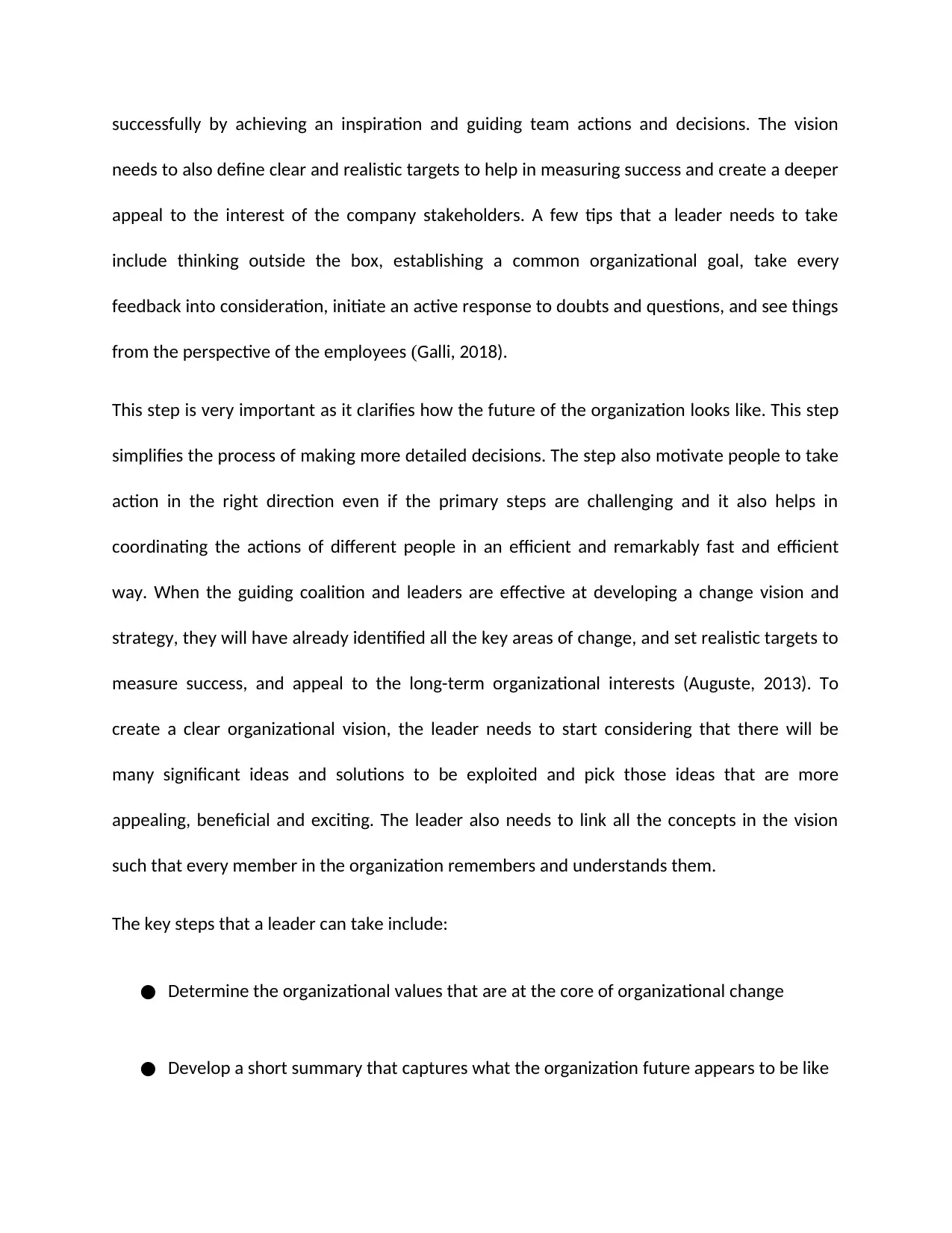
successfully by achieving an inspiration and guiding team actions and decisions. The vision
needs to also define clear and realistic targets to help in measuring success and create a deeper
appeal to the interest of the company stakeholders. A few tips that a leader needs to take
include thinking outside the box, establishing a common organizational goal, take every
feedback into consideration, initiate an active response to doubts and questions, and see things
from the perspective of the employees (Galli, 2018).
This step is very important as it clarifies how the future of the organization looks like. This step
simplifies the process of making more detailed decisions. The step also motivate people to take
action in the right direction even if the primary steps are challenging and it also helps in
coordinating the actions of different people in an efficient and remarkably fast and efficient
way. When the guiding coalition and leaders are effective at developing a change vision and
strategy, they will have already identified all the key areas of change, and set realistic targets to
measure success, and appeal to the long-term organizational interests (Auguste, 2013). To
create a clear organizational vision, the leader needs to start considering that there will be
many significant ideas and solutions to be exploited and pick those ideas that are more
appealing, beneficial and exciting. The leader also needs to link all the concepts in the vision
such that every member in the organization remembers and understands them.
The key steps that a leader can take include:
● Determine the organizational values that are at the core of organizational change
● Develop a short summary that captures what the organization future appears to be like
needs to also define clear and realistic targets to help in measuring success and create a deeper
appeal to the interest of the company stakeholders. A few tips that a leader needs to take
include thinking outside the box, establishing a common organizational goal, take every
feedback into consideration, initiate an active response to doubts and questions, and see things
from the perspective of the employees (Galli, 2018).
This step is very important as it clarifies how the future of the organization looks like. This step
simplifies the process of making more detailed decisions. The step also motivate people to take
action in the right direction even if the primary steps are challenging and it also helps in
coordinating the actions of different people in an efficient and remarkably fast and efficient
way. When the guiding coalition and leaders are effective at developing a change vision and
strategy, they will have already identified all the key areas of change, and set realistic targets to
measure success, and appeal to the long-term organizational interests (Auguste, 2013). To
create a clear organizational vision, the leader needs to start considering that there will be
many significant ideas and solutions to be exploited and pick those ideas that are more
appealing, beneficial and exciting. The leader also needs to link all the concepts in the vision
such that every member in the organization remembers and understands them.
The key steps that a leader can take include:
● Determine the organizational values that are at the core of organizational change
● Develop a short summary that captures what the organization future appears to be like
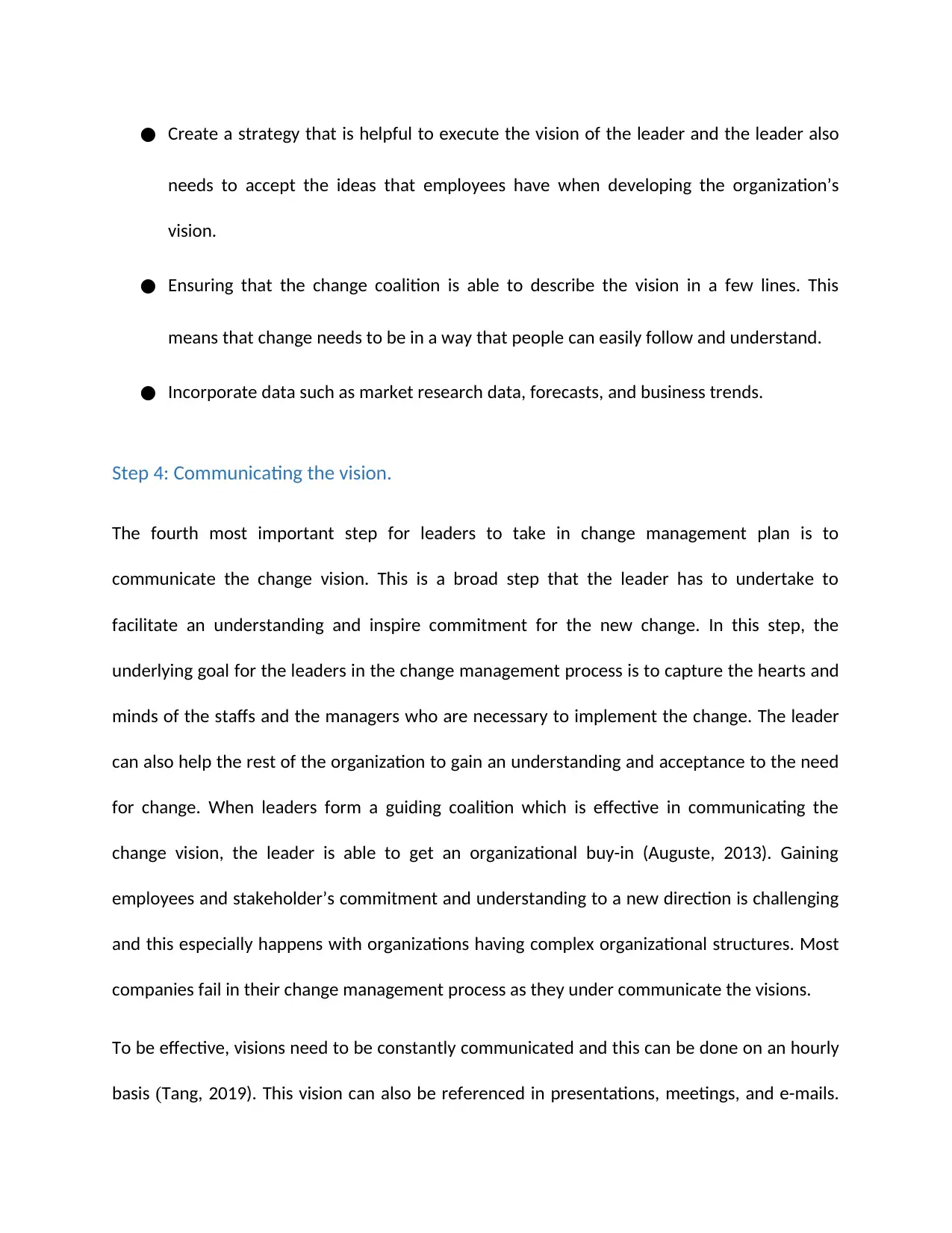
● Create a strategy that is helpful to execute the vision of the leader and the leader also
needs to accept the ideas that employees have when developing the organization’s
vision.
● Ensuring that the change coalition is able to describe the vision in a few lines. This
means that change needs to be in a way that people can easily follow and understand.
● Incorporate data such as market research data, forecasts, and business trends.
Step 4: Communicating the vision.
The fourth most important step for leaders to take in change management plan is to
communicate the change vision. This is a broad step that the leader has to undertake to
facilitate an understanding and inspire commitment for the new change. In this step, the
underlying goal for the leaders in the change management process is to capture the hearts and
minds of the staffs and the managers who are necessary to implement the change. The leader
can also help the rest of the organization to gain an understanding and acceptance to the need
for change. When leaders form a guiding coalition which is effective in communicating the
change vision, the leader is able to get an organizational buy-in (Auguste, 2013). Gaining
employees and stakeholder’s commitment and understanding to a new direction is challenging
and this especially happens with organizations having complex organizational structures. Most
companies fail in their change management process as they under communicate the visions.
To be effective, visions need to be constantly communicated and this can be done on an hourly
basis (Tang, 2019). This vision can also be referenced in presentations, meetings, and e-mails.
needs to accept the ideas that employees have when developing the organization’s
vision.
● Ensuring that the change coalition is able to describe the vision in a few lines. This
means that change needs to be in a way that people can easily follow and understand.
● Incorporate data such as market research data, forecasts, and business trends.
Step 4: Communicating the vision.
The fourth most important step for leaders to take in change management plan is to
communicate the change vision. This is a broad step that the leader has to undertake to
facilitate an understanding and inspire commitment for the new change. In this step, the
underlying goal for the leaders in the change management process is to capture the hearts and
minds of the staffs and the managers who are necessary to implement the change. The leader
can also help the rest of the organization to gain an understanding and acceptance to the need
for change. When leaders form a guiding coalition which is effective in communicating the
change vision, the leader is able to get an organizational buy-in (Auguste, 2013). Gaining
employees and stakeholder’s commitment and understanding to a new direction is challenging
and this especially happens with organizations having complex organizational structures. Most
companies fail in their change management process as they under communicate the visions.
To be effective, visions need to be constantly communicated and this can be done on an hourly
basis (Tang, 2019). This vision can also be referenced in presentations, meetings, and e-mails.
⊘ This is a preview!⊘
Do you want full access?
Subscribe today to unlock all pages.

Trusted by 1+ million students worldwide
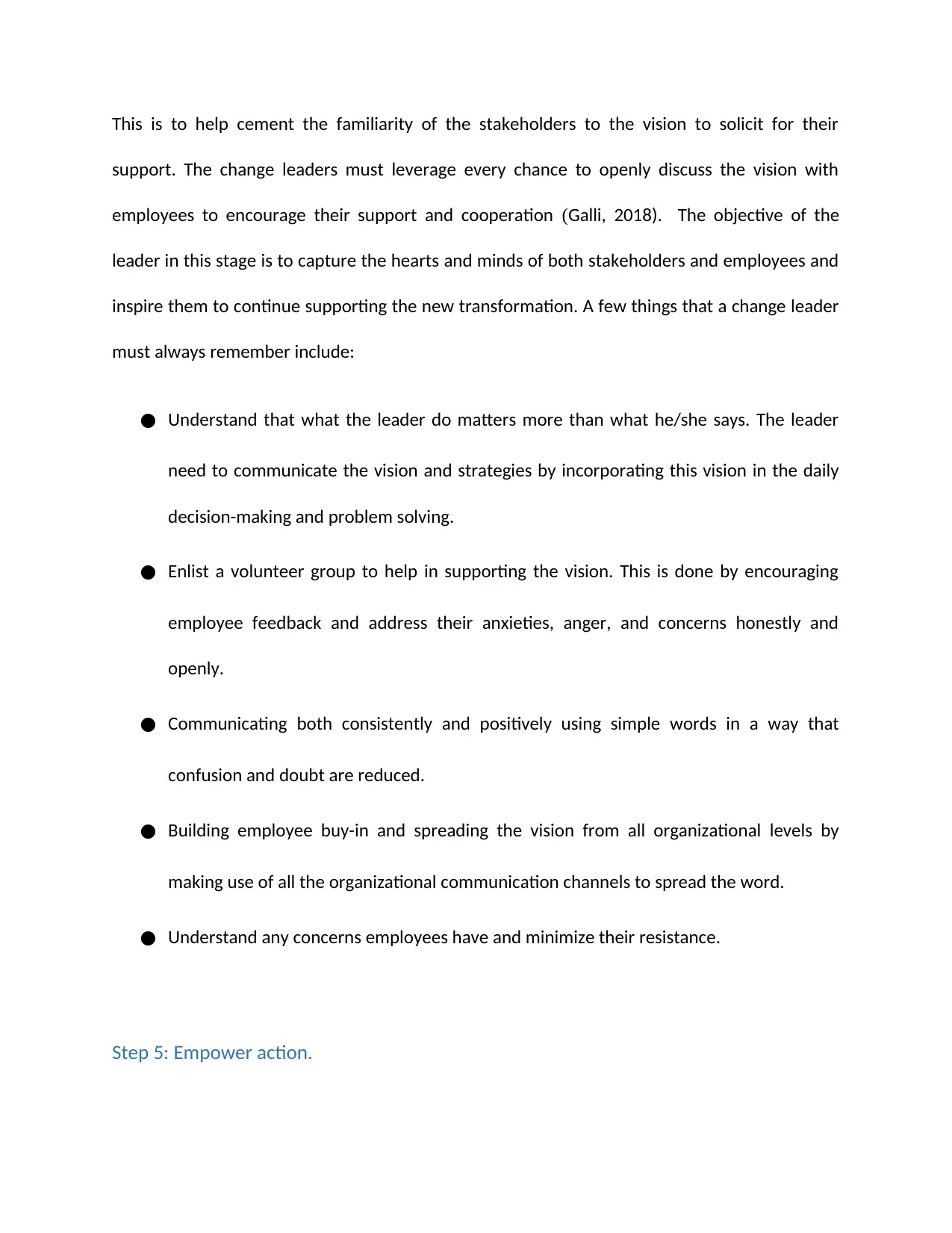
This is to help cement the familiarity of the stakeholders to the vision to solicit for their
support. The change leaders must leverage every chance to openly discuss the vision with
employees to encourage their support and cooperation (Galli, 2018). The objective of the
leader in this stage is to capture the hearts and minds of both stakeholders and employees and
inspire them to continue supporting the new transformation. A few things that a change leader
must always remember include:
● Understand that what the leader do matters more than what he/she says. The leader
need to communicate the vision and strategies by incorporating this vision in the daily
decision-making and problem solving.
● Enlist a volunteer group to help in supporting the vision. This is done by encouraging
employee feedback and address their anxieties, anger, and concerns honestly and
openly.
● Communicating both consistently and positively using simple words in a way that
confusion and doubt are reduced.
● Building employee buy-in and spreading the vision from all organizational levels by
making use of all the organizational communication channels to spread the word.
● Understand any concerns employees have and minimize their resistance.
Step 5: Empower action.
support. The change leaders must leverage every chance to openly discuss the vision with
employees to encourage their support and cooperation (Galli, 2018). The objective of the
leader in this stage is to capture the hearts and minds of both stakeholders and employees and
inspire them to continue supporting the new transformation. A few things that a change leader
must always remember include:
● Understand that what the leader do matters more than what he/she says. The leader
need to communicate the vision and strategies by incorporating this vision in the daily
decision-making and problem solving.
● Enlist a volunteer group to help in supporting the vision. This is done by encouraging
employee feedback and address their anxieties, anger, and concerns honestly and
openly.
● Communicating both consistently and positively using simple words in a way that
confusion and doubt are reduced.
● Building employee buy-in and spreading the vision from all organizational levels by
making use of all the organizational communication channels to spread the word.
● Understand any concerns employees have and minimize their resistance.
Step 5: Empower action.
Paraphrase This Document
Need a fresh take? Get an instant paraphrase of this document with our AI Paraphraser

This is a crucial step that entail removing obstacles to change, changing structures or systems
that have an effect in undermining the vision, encouraging risk taking and assumption of non-
traditional activities, ideas, and actions. In the process of empowering broad-based actions, this
may involve a leader taking actions to change the management information systems or
organizational structure to that reporting relationships and information support needed actions
(Galli, 2018). There are some barriers that can affect an effective change and this can be
troublesome to supervisors with the management styles that can affect the change. The leaders
are supposed to understand that easy solutions to the problem of empowering actions. This is
why the best solution that a leader can take should be taking an honest dialogue. The following
are some of the steps that a leader can take to make this happen.
● The leader needs to record all the obstacles and barriers from both the management
and employees perspectives.
● It is important that the leader develop a clear understanding of each obstacle, divide
them individually in the form of physical barriers, organizational traditions, or legislation
obstacles.
● Understand all barriers that hinder organizational transformation process and address
these barriers at the earliest time possible.
To follow these steps, a leader is expected to empower the employees by openly
communicating with them to identify the barriers, identifying the obstacles that are most
resistant to the revolution and resolve them, use industry leaders to deliver the change, and
finally offer rewards to employees to actively work on implementing the transformation
that have an effect in undermining the vision, encouraging risk taking and assumption of non-
traditional activities, ideas, and actions. In the process of empowering broad-based actions, this
may involve a leader taking actions to change the management information systems or
organizational structure to that reporting relationships and information support needed actions
(Galli, 2018). There are some barriers that can affect an effective change and this can be
troublesome to supervisors with the management styles that can affect the change. The leaders
are supposed to understand that easy solutions to the problem of empowering actions. This is
why the best solution that a leader can take should be taking an honest dialogue. The following
are some of the steps that a leader can take to make this happen.
● The leader needs to record all the obstacles and barriers from both the management
and employees perspectives.
● It is important that the leader develop a clear understanding of each obstacle, divide
them individually in the form of physical barriers, organizational traditions, or legislation
obstacles.
● Understand all barriers that hinder organizational transformation process and address
these barriers at the earliest time possible.
To follow these steps, a leader is expected to empower the employees by openly
communicating with them to identify the barriers, identifying the obstacles that are most
resistant to the revolution and resolve them, use industry leaders to deliver the change, and
finally offer rewards to employees to actively work on implementing the transformation

process (Galli, 2018). It is the role of leaders to create a guiding coalition consisting of
employees with different expertise. The leader should ensure that organizational structures,
processes, policies, and reward systems are aligned with the new vision of change. More
importantly, the leader should empower employees to do their best and face challenges
successfully by offering employees with the necessary coaching, training, and mentoring. In the
long-run, the coalition that the management builds helps the leader to navigate through this
step by creating a huge difference in the acceptance of change. The coalition bridge the gap
between performance and reducing the resistance to change.
Step 6: Create quick wins.
This is a crucial step which entails creating unambiguous and visible success as soon as possible.
In this stage, the guiding coalition already built helps the leader by becoming the key force to
help in identifying significant improvements that can occur between six and eighteen months
(Tang, 2019). It is important to get these wins as it helps to ensure the success of the overall
change initiative. According to research, companies that experience short-term wins by a
period between fourteen and twenty-six months are in a better position to succeed the change
transformation (Auguste, 2013). This is because the short wins are helpful in creating evidence
of the sacrifices that people are making are eventually paying off. Conventionally, by creating
short wins, it increases a sense of urgency and optimism of the individuals involved in the
change.
In this stage, change leaders need to understand that success is the best motivation. In the
process of transformation, giving employees a taste of success at the earliest possible time is
employees with different expertise. The leader should ensure that organizational structures,
processes, policies, and reward systems are aligned with the new vision of change. More
importantly, the leader should empower employees to do their best and face challenges
successfully by offering employees with the necessary coaching, training, and mentoring. In the
long-run, the coalition that the management builds helps the leader to navigate through this
step by creating a huge difference in the acceptance of change. The coalition bridge the gap
between performance and reducing the resistance to change.
Step 6: Create quick wins.
This is a crucial step which entails creating unambiguous and visible success as soon as possible.
In this stage, the guiding coalition already built helps the leader by becoming the key force to
help in identifying significant improvements that can occur between six and eighteen months
(Tang, 2019). It is important to get these wins as it helps to ensure the success of the overall
change initiative. According to research, companies that experience short-term wins by a
period between fourteen and twenty-six months are in a better position to succeed the change
transformation (Auguste, 2013). This is because the short wins are helpful in creating evidence
of the sacrifices that people are making are eventually paying off. Conventionally, by creating
short wins, it increases a sense of urgency and optimism of the individuals involved in the
change.
In this stage, change leaders need to understand that success is the best motivation. In the
process of transformation, giving employees a taste of success at the earliest possible time is
⊘ This is a preview!⊘
Do you want full access?
Subscribe today to unlock all pages.

Trusted by 1+ million students worldwide
1 out of 19
Related Documents
Your All-in-One AI-Powered Toolkit for Academic Success.
+13062052269
info@desklib.com
Available 24*7 on WhatsApp / Email
![[object Object]](/_next/static/media/star-bottom.7253800d.svg)
Unlock your academic potential
Copyright © 2020–2025 A2Z Services. All Rights Reserved. Developed and managed by ZUCOL.





